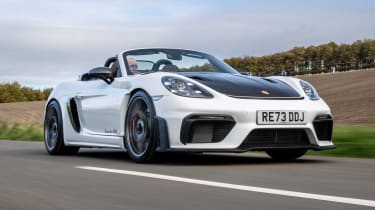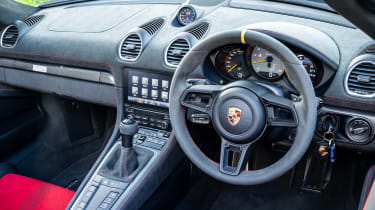Porsche 718 Spyder RS 2024 review: a fitting and ferocious finale
Has Porsche saved the best for last by putting a GT3 engine into a lightweight, hardcore 718 Boxster?
Verdict
The Porsche 718 Spyder RS provides the cerebral overload you might expect given that its GT3-based engine breathes in only inches from your earlobes. This is a stunning finale for the petrol-powered Porsche Boxster, a model that’s delivered decades of superb sports cars, but it’s so fast, so intense and so uncompromising that you need to be on the right road, and in the right headspace, to enjoy it.
The Porsche Boxster might well be one of the more familiar sports car shapes on the road, but there’s no overlooking the presence of the new Spyder RS when parked alongside more mundane traffic. This ultimate version of Porsche’s entry-level mid-engined sports car is the current combustion model’s swansong before it goes electric in the next generation, expanding our notion of what a Porsche can be just as the original Boxster did back in 1996.
Behind its chopped windscreen, vast rear tonneau and exposed carbon fibre bonnet sits the real reason for the exalted status of the Spyder RS. This is the first, and will be the only, mid-engined Boxster to feature the full-house flat-six engine from the Porsche 911 GT3. Despite sharing the same capacity, the 4.0-litre engine in the standard Boxster Spyder is a bored-out 3.0-litre unit, but the RS Spyder has the genuine article.
More reviews
Due to a slightly more restrictive exhaust system, the peak power figure is a convenient 10bhp less than the GT3’s at 493bhp. That still comfortably makes this the most powerful Boxster ever, and performance is further boosted by the extensive weight saving programme that’s been undertaken on the car. Torque isn’t really what this engine’s about, the maximum output being a seemingly meagre 450Nm, but the trade-off is its high-revving nature and the redline on the bespoke analogue tachometer sitting at 9,000rpm. The engine also now breathes through a pair of intakes mounted just behind the seats, only inches from your earlobes, creating an intense sound under hard acceleration.
Like all modern Porsche RS models, the sole transmission option is a seven-speed dual-clutch, which feels more rudimentary in its low-speed operations than the usually slick PDK. Power is then sent to the rear wheels via a limited-slip differential, getting the RS to 62mph in just 3.4 seconds before it tops out at 191mph – with the ‘temporary’ roof stowed it must be said. Yet while this sort of acceleration isn’t particularly unusual in our era of high performance EVs, the experience is an intensely physical one, as is almost every bit of the car.
Alongside the extra power, Porsche has ripped out most of the standard Boxster’s sound insulation and fitted a raft of lightweight elements. These include the fiddly carbon fibre roof, but also the vented front wings, forged wheels and carbon fibre bucket seats. The result is a 1,410kg weight figure, an impressive result considering it’s got 4-litres of swept capacity and a dual-clutch transmission.
Our specific example was fitted with the £9,390 Weissach-package without the optional titanium wheels. This adds a range of carbon fibre elements such as the third-brake light bridge and the gurney flap on the ducktail, while also leaving the bonnet carbon weave exposed and adding a bunch of Weissach logos on the roof, seats and dash.
Settle into the familiar cabin and it can feel a tad dated, even comprehensively wrapped in Porsche’s soft-touch Race-tex fabric – another addition as part of the Weissach-package. Twist the fob into the dash, however, and the resulting sense of drama will never get old. After a brief whirr of the starter motor, the exhaust clears its throat with the valves wide open before settling to a busy idle with the single-mass flywheel chattering away alongside. Thunk the tall PDK lever from P to D and the clutch will clumsily engage once you’ve applied a bit of throttle, completely ignoring any notion of smoothness or subtlety.
When driving at low speeds you can feel the firmness typically associated with Porsche’s RS models, and when on full-lock the front Michelin tyres have so much negative camber that they skip forward at what feels like a foot at a time. But the RS isn’t a town car, which is handy because at speed it transforms.
With some load in the chassis, the Boxster seems to generate suspension travel out of thin air, as the body somehow breathes with the road with absolute precision. The front end is able to generate a stunning amount of grip – so long as the aggressive standard-fit Cup 2 tyres have some heat in them – and crucially is able to communicate this through the steering.
In fact, it’s the rear end that will more easily become unstuck as despite the relatively small on-paper torque figure and long gearing, the RS is more than happy to over-spin its rear wheels. Driving at a comfortable speed on even the most challenging roads feels like you’re only dipping into a small percentage of its ability but rather than being a reassurance, it often feels like more of a challenge from the car. It goads you into driving faster, braking harder and putting more and more faith into the front end.
Which is where the issue lies. With so much performance and the relatively long gearing of the PDK, you can easily end up travelling just too fast for the road. The thrilling sweet spot between the Spyder RS being irritating at low speeds and illegal at higher ones is just too small. There’s no doubting the incredible performance, or the fact that it feels like this is the very apex of six-cylinder sports car design and engineering, but there’s often just too much at stake to enjoy the RS Spyder with complete confidence.
This remains an incredible achievement from Porsche, though, it’s more a case that the road and driver often don’t feel worthy of the car.
| Model: | Porsche 718 Spyder RS |
| Price: | £123,000 |
| Engine: | 4.0-litre flat-six |
| Power/torque: | 493bhp/450Nm |
| Transmission: | Seven-speed dual-clutch automatic, rear-wheel drive |
| 0-62mph: | 3.4 seconds |
| Top speed: | 191mph |
| Economy: | 21.7mpg |
| CO2: | 294g/km |
| L/W/H: | 4,418/1,994/1,252mm |
| On sale: | Now |





